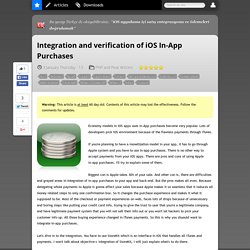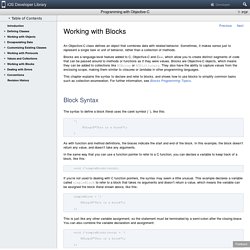

UIView With Shadow and Rounded Corners - App-it.dk. Integration and verification of iOS In-App Purchases - PHP and Pear Articles - Articles - mfyz.com. Economy models in iOS apps uses In-App purchases become very popular.

Lots of developers pick iOS environment because of the flawless payments through iTunes. If you're planning to have a monetization model in your app, it has to go through Apple system and you have to use in-app purchases. There is no other way to accept payments from your iOS apps. There are pros and cons of using Apple in-app purchases. I'll try to explain some of them. Biggest con is Apple takes 30% of your sale. Let's dive in to the integration. After integration of StoreKit, when user triggers a payment (with tapping a button or something like that) you call StoreKit and iOS shows a confirmation box of your product, price and after that user confirms their iTunes password and StoreKit gives you a "receipt-data" object which is an encoded string holds the receipt details.
Some amateur developers doesn't feel the necessity of verifying the receipts they received from StoreKit. Here is the response json object: Working with Blocks. An Objective-C class defines an object that combines data with related behavior.

Sometimes, it makes sense just to represent a single task or unit of behavior, rather than a collection of methods. Blocks are a language-level feature added to C, Objective-C and C++, which allow you to create distinct segments of code that can be passed around to methods or functions as if they were values. Blocks are Objective-C objects, which means they can be added to collections like NSArray or NSDictionary.
They also have the ability to capture values from the enclosing scope, making them similar to closures or lambdas in other programming languages. This chapter explains the syntax to declare and refer to blocks, and shows how to use blocks to simplify common tasks such as collection enumeration. Block Syntax The syntax to define a block literal uses the caret symbol (^), like this: As with function and method definitions, the braces indicate the start and end of the block. iPhone Programming Fundamentals - Outlets and Actions.
An understanding of outlets and actions is one of the first things you will need for iPhone programming.

For someone coming from the .NET background, this is a concept that requires some time to get used to - the concepts are similar, but it is a different way of doing things. And so, in this article, I am going to show you what outlets and actions are. At the end of this article, you will have a solid understanding of how to create outlets and actions, and be on your way to creating great iPhone apps. First, the basics So let's start by creating a really simple project to see how everything fits together.
Ios - Autoresizing masks programmatically vs Interface Builder / xib / nib. Objective-C Typedef. The Objective-C programming language provides a keyword called typedef, which you can use to give a type a new name.

Following is an example to define a term BYTE for one-byte numbers: typedef unsigned char BYTE; After this type definition, the identifier BYTE can be used as an abbreviation for the type unsigned char, for example:. BYTE b1, b2; By convention, uppercase letters are used for these definitions to remind the user that the type name is really a symbolic abbreviation, but you can use lowercase, as follows: typedef unsigned char byte; You can use typedef to give a name to user-defined data type as well. When the above code is compiled and executed, it produces the following result: 2013-09-12 12:21:53.745 demo[31183] Book title : Objective-C Programming 2013-09-12 12:21:53.745 demo[31183] Book author : TutorialsPoint 2013-09-12 12:21:53.745 demo[31183] Book subject : Programming tutorial 2013-09-12 12:21:53.745 demo[31183] Book Id : 100.
AppCode. Memory management. Nib file. CollectionView. UIViewController. Build. Drawing. Message sent to deallocated instance. If I change the price of an auto-renewing subscription, what happens to existing subscribers? - Quora.